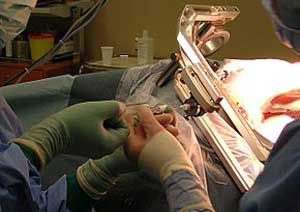- Home
- Editorial
- News
- Practice Guidelines
- Anesthesiology Guidelines
- Cancer Guidelines
- Cardiac Sciences Guidelines
- Critical Care Guidelines
- Dentistry Guidelines
- Dermatology Guidelines
- Diabetes and Endo Guidelines
- Diagnostics Guidelines
- ENT Guidelines
- Featured Practice Guidelines
- Gastroenterology Guidelines
- Geriatrics Guidelines
- Medicine Guidelines
- Nephrology Guidelines
- Neurosciences Guidelines
- Obs and Gynae Guidelines
- Ophthalmology Guidelines
- Orthopaedics Guidelines
- Paediatrics Guidelines
- Psychiatry Guidelines
- Pulmonology Guidelines
- Radiology Guidelines
- Surgery Guidelines
- Urology Guidelines
Real-time MRI-guided brain biopsy is accurate diagnostic option for brain lesions

Real-time MR-guided brain biopsy using a 1.0-T open MRI scanner is a safe, feasible and accurate diagnostic technique for pathological diagnosis of brain lesions, according to a new study published in the journal European Radiology. The results further demonstrate that the use of this technique shortens the duration procedure and simplifies biopsy workflow It could be considered as an alternative for brain biopsy.
Chengli Li, Department of Interventional MRI, Shandong Medical Imaging Research Institute, Jinan, China, and colleagues conducted the study to evaluate the safety, feasibility and diagnostic performance of real-time MR-guided brain biopsy using a 1.0-T open MRI scanner.
Key Takeaways from the Study:
- Real-time MRI-guided brain biopsy using a 1.0-T open MRI scanner is safe, feasible and accurate.
- No serious complications occurred in real-time MRI-guided brain biopsy.
- Procedure duration is shortened and biopsy workflow is simplified.
Read Also: World’s first robotic neurosurgery inside MRI Scanner
The researchers retrospectively evaluated medical records of 86 consecutive participants who underwent brain biopsy under the guidance of a 1.0-T open MRI scanner with real-time and MR fluoroscopy techniques. All procedures were performed under local anesthesia and intravenous conscious sedation. Diagnostic yield, diagnostic accuracy, complication rate and procedure duration were assessed. The lesions were divided into two groups according to maximum diameters: ≤ 1.5 cm (n = 16) and > 1.5 cm (n = 70). The two groups were compared using Fisher’s exact test.
Key Findings:
- Diagnostic yield and diagnostic accuracies were 95.3% and 94.2%, respectively.
- The diagnostic yield of lesions ≤ 1.5 cm and > 1.5 cm was 93.8% and 95.7%, respectively.
- There was no significant difference in diagnostic yield between the two groups.
- Mean procedure duration was 41 ± 5 min (range 33–49 min). All biopsy needles were placed with one pass.
- The complication rate was 3.5% (3/86).
- Minor complications included three cases of a small amount of hemorrhage.
- No serious complications were observed.

Disclaimer: This site is primarily intended for healthcare professionals. Any content/information on this website does not replace the advice of medical and/or health professionals and should not be construed as medical/diagnostic advice/endorsement or prescription. Use of this site is subject to our terms of use, privacy policy, advertisement policy. © 2020 Minerva Medical Treatment Pvt Ltd